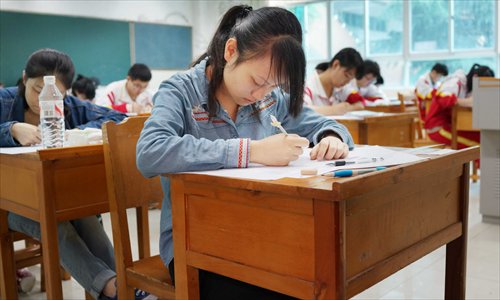HOME >> CHINA
Put to the test
Source:Xinhua-Global Times Published: 2014-9-9 20:58:01
Gaokao overhaul to even playing field for college-bound hopefuls

Students in Guiyang, Guizhou Province sit China's college entrance examinations on June 7. Photo: CFP
China plans to overhaul its decades-old college entrance examinations and university enrollment system by 2020, to improve fairness and transparency.
The plan, outlined in a circular released by the State Council on Thursday, will ease the pressure on students, Vice Education Minister Du Yubo told a press conference.
Usually held in early June, the examinations, also known as gaokao, is the sole entrance criteria for most colleges and widely regarded as a fair path upward in society. These will be the biggest changes to gaokao since it was reintroduced in 1977, following the Cultural Revolution (1966-76), said Du.
Widely regarded as the principal determinant of the future of students, there has been an unhealthy emphasis on the role of gaokao.
"The current exam has attracted criticism due to its overemphasis on numerical scores, which has skewed the rounded development of students," said Du. "Reform of the exam is in everyone's interests and the plan was devised after public consultation, heated discussion and repeated revision."
New measures
Targeting existing issues, the plan contains several steps to ensure the college recruitment system becomes fairer, centering on better selection of students based on their actual skills and talents.
Currently, most students enter university by taking a fixed, universal diet of exam subjects in science or arts.
Students may now submit the scores of three subjects taken throughout high school from a pool of six biology, chemistry, geography, history, physics and politics together with mandatory scores from their exams in Chinese, math and English. Students may retake their English proficiency test once, and submit the better score.
There is also a problem of "extra" scores, often at the center of recruitment scandals, to be solved. Extra scores are usually awarded for sporting or artistic achievement, such as playing a musical instrument. Loose supervision of these extra scores has lead to widespread cheating.
According to the Ministry of Education, China has about 2,500 higher education institutes, of which 1,300 are vocational colleges. The vocational college entrance examinations will be split off from the general college examinations, putting technical talent on a similar footing to academic ability.
Pilot programs for high school freshmen in Shanghai and Zhejiang Province will begin this year and will be expanded nationwide after three years, said Du.
Promote equality
Around 9.12 million high school students were registered to sit the gaokao in 2013. The figures for those sitting the exam have declined year-on-year for five years.
Education experts said that some students from rural areas may also not bother with gaokao, as they see no hope of entering colleges, cannot afford the tuition fees and worry about finding jobs after graduation.
With vast regional differences in quality and access to universities, largely due to gaps in development and differences in population, a sweeping reworking of the system will help students from underdeveloped areas to compete on more equal terms with their peers from more affluent areas.
"The government has been trying to narrow regional disparities in education for years," Du said.
The average enrollment rate after the 2013 gaokao was 76 percent, with the lowest region enrolling 70 percent. This 6 percent gap was down from 17 percent in 2007. The target is "less than four" by 2017.
Measures to level the playing field include adjusting enrollment quotas to increase recruitment of students from central, western and populous regions. Current quotas require all universities admit a flat number of non-local students each year. Students from heavily populated provinces, such Shandong, complain this makes competition too fierce, with tens of thousands of high school graduates vying for a limited number of slots for local students. Making quotas more transparent is important in revising the system, Du said.
Students from central and western parts will continue to enjoy preferential enrollment policies that have benefited roughly 200,000 students this year, he said.
The government will also help students from poorer provinces get into top universities. Although the percentage of students originating in rural areas entering universities is similar to that of urban students, far fewer of them go to top schools, ostensibly due to the quality gap in primary and secondary education.
One of the changes already in place has been to assign a quota for students from poor, remote and ethnic minority regions to first-class universities.
This year, enrollment at top universities by students from rural areas grew by 11.4 percent, with roughly 50,000 students from 832 impoverished counties in 22 provinces gaining entrance to top universities, Du said.
The plan also required more provinces to use nationwide standardized exam papers. Sixteen provincial regions, such as Beijing, currently have the power to draft their own exam papers. The current policy has stirred controversy with many crying unfair as the difficulty level among various regions cannot be unified, yet students are selected based on their scores.
However, the reform did not touch the current birthplace-specific examination policy, which is a main reason causing education inequality, an editorial on Shanghai-based eastday.com noted. It is a pity for the reform which is aimed at ensuring the education equality, said the media outlet.
The policy ruled that most of student can only take examinations in their hometown in line with their household registration. The policy caused troubles for migrant workers' children as they cannot take examination where they live.
A commentary on People's Daily on Friday noted that to increase the number of rural areas students in top universities can help solve this inequality to some degree as it ensures students from different areas in China can enjoy relatively equal opportunities to enter universities.
Posted in: Society